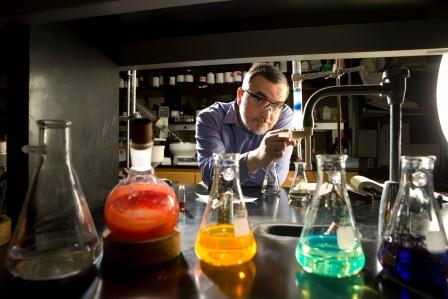by Erin Holady Ziegler
 As one of the foremost experts on organic electronic materials and carbon solar cell design, University of Kentucky chemistry professor John Anthony enjoys creating materials in order to do things.
As one of the foremost experts on organic electronic materials and carbon solar cell design, University of Kentucky chemistry professor John Anthony enjoys creating materials in order to do things.
"What many people fail to remember is that everything in our lives, including ourselves, is made from chemicals," Anthony said. "My goal every day is to make my electronic materials stronger, lighter and more stable."
But sometimes Anthony, taking a pause from his work in the pragmatic and applied, likes to have a little fun.
Fun for Anthony involves acenes, a class of organic compounds that play a pivotal role in the development of the organic electronic materials that the College of Arts & Sciences Hubbard Professor of Chemistry spends quite a lot of time with.
In order to prepare useful and stable materials from aromatic compounds, a thorough understanding of the physical and electronic properties of acenes is essential.
Acenes are made up of linear, fused benzene rings. Anthony is "consistently designing molecules that come together for certain reasons and in certain ways."
The materials available for larger acene exploration essentially stop at five linked rings, called pentacenes, although Anthony and his team created a stable hexacene and heptacene in 2005.
With all the previous acene achievement, Anthony was ready for another challenge — or some "fun," as he describes.
Anthony and UK graduate student Balaji Purushothaman set out to create an acene with nine rings, and due to their previous experience with hexacene and heptacene formation, they succeeded, as shown by Anthony's recent VIP article in Angewandte Chemie, titled "Synthesis and Structural Characterization of Crystalline Nonacenes."
"It was an honor and a joy to write up the paper," said Anthony, of the research project funded by the National Science Foundation. "These linearly-connected hydrocarbons have made significant contributions to the understanding of electronic processes in organic semiconductors, and it was important to set the literature straight."
Anthony's cover article for Angewandte Chemie casts doubt previous organic materials research claiming to already have created a nonacene.
The previous assertion of nonacene formation, according to Anthony, was impossible, due to the molecule's red-colored emission of light.
"Any bright red color for a molecule with such a small optical gap goes directly against Kasha's rule, which is one of the foundational laws of organic photophysics," he explained. "When we saw that this researcher claimed to see red, we had to do something."
The emission of red light is typical of much smaller acenes, which would be formed by decomposition of larger compounds such as nonacene.
Anthony and his team have proven that nonacenes are, in fact, possible to create, which bodes well for the future of organic materials research.
Stabilizing organic materials can take a long time, and the longer a chemical process takes, the more it costs. "The more we know about the underlying compounds, the more stable the product we can create," said Anthony. "We have to think about how these compounds interact and design molecules that they want to be close to."
Anthony's "fun" gives researchers yet another opportunity to create more stabilized carbon products, lighter solar cells and cheaper energy.
Angewandte Chemie is the flagship journal of the German Chemical Society and one of the highest impact chemistry journals in the world.
